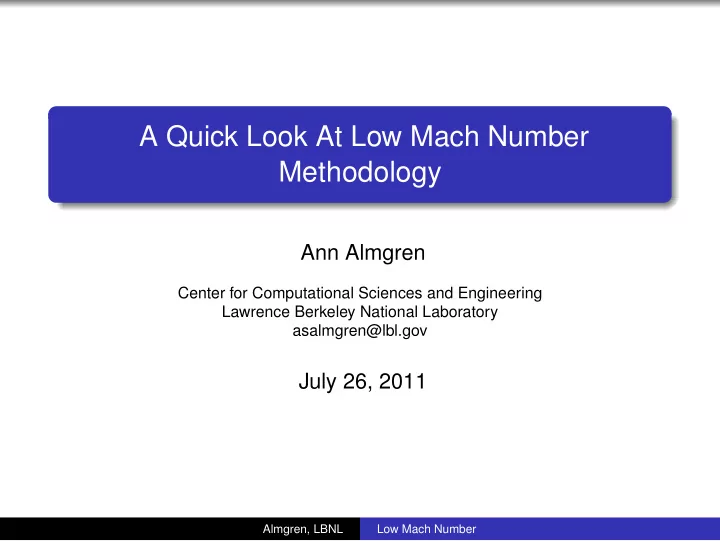

A Quick Look At Low Mach Number Methodology Ann Almgren Center for Computational Sciences and Engineering Lawrence Berkeley National Laboratory asalmgren@lbl.gov July 26, 2011 lab-logo Almgren, LBNL Low Mach Number
Low Mach Number: Why? For explosions themselves, it is critical to resolve shocks and supersonic phenomena. However, during the period preceding an explosion, the flow may be low Mach number, and a low Mach number method can be useful. Simulations of Type Ia supernovae are very sensitive to the location and number of ignition points (“hot spots”) To understand the conditions in the star at the time of ignition, we need to simulate hours instead of seconds Dynamics of convection are driven by perturbational density which is much smaller than the background density lab-logo Almgren, LBNL Low Mach Number
Low Mach Number formulation A low Mach number method: exploits natural separation of scales between fluid motion (at speed U ≪ c ) and acoustic wave propagation (at speed c ) guarantees hydrostatic balance of the background state (by construction). takes a much larger time step and still captures the relevant physics. Recall that all currently-available hydro codes are parallel in space but serial in time – low Mach number approximation costs more per time step but takes many fewer time steps. lab-logo Almgren, LBNL Low Mach Number
Low Mach Number Asymptotics Asymptotic analysis shows that: π/ p 0 ∼ O ( M 2 ) p ( x , t ) = p 0 ( r , t ) + π ( � x , t ) where p 0 affects only the thermodynamics; π affects only the local dynamics, Physically: acoustic equilibration is instantaneous; sound waves are “filtered” out Mathematically: resulting equation set is no longer strictly hyperbolic; a constraint equation is added to the evolution equations Computationally: time step is dictated by fluid velocity, not sound speed. Anelastic methods are one type of low Mach number method. They can include Background stratification Nonideal equation of state but require that perturbations in density and temperature be small. For modeling ignition in a white dwarf, we need a more general model that also allows: Finite perturbations in density and temperature Local compressibility from heat release and compositional changes lab-logo Overall expansion of the star Almgren, LBNL Low Mach Number
Low Mach Number Equations Our basic hydrodynamic equations now look like Mass ρ t + ∇ · ρ U = 0 ( ρ U ) t + ∇ · ( ρ UU + π ) = ( ρ − ρ 0 ) � Momentum g Energy ( ρ h ) t + ∇ · ( ρ Uh ) = ∇ · κ ∇ T Species ( ρ X m ) t + ∇ · ( ρ UX m ) = ˙ ω m This new system still needs to be “closed” EOS is transformed into a constraint on the velocity field: ∇ · ( β 0 U ) = β 0 S Reactions – same as always, though we are taking a bigger time step so coupling can become an issue Gravity – here it is well defined as function of ρ 0 ( r , t ) lab-logo Almgren, LBNL Low Mach Number
Rising Bubbles Mach number of rising bubbles as calculated with a compressible (above) vs low Mach number (below) algo- rithm. Features of the bubbles themselves are identical M ≈ 10 − 4 so pressure difference is O ( 10 − 8 ) For more information, see http://www.astro.sunysb.edu/mzingale/Maestro/ https://ccse.lbl.gov/Research/MAESTRO lab-logo Almgren, LBNL Low Mach Number
Recommend
More recommend